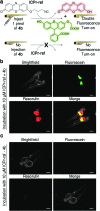Isonitrile-responsive and bioorthogonally removable tetrazine protecting groups
- PMID: 32110368
- PMCID: PMC7012038
- DOI: 10.1039/c9sc04649f
Isonitrile-responsive and bioorthogonally removable tetrazine protecting groups
Abstract
In vivo compatible reactions have a broad range of possible applications in chemical biology and the pharmaceutical sciences. Here we report tetrazines that can be removed by exposure to isonitriles under very mild conditions. Tetrazylmethyl derivatives are easily accessible protecting groups for amines and phenols. The isonitrile-induced removal is rapid and near-quantitative. Intriguingly, the deprotection is especially effective with (trimethylsilyl)methyl isocyanide, and serum albumin can catalyze the elimination under physiological conditions. NMR and computational studies revealed that an imine-tautomerization step is often rate limiting, and the unexpected cleavage of the Si-C bond accelerates this step in the case with (trimethylsilyl)methyl isocyanide. Tetrazylmethyl-removal is compatible with use on biomacromolecules, in cellular environments, and in living organisms as demonstrated by cytotoxicity experiments and fluorophore-release studies on proteins and in zebrafish embryos. By combining tetrazylmethyl derivatives with previously reported tetrazine-responsive 3-isocyanopropyl groups, it was possible to liberate two fluorophores in vertebrates from a single bioorthogonal reaction. This chemistry will open new opportunities towards applications involving multiplexed release schemes and is a valuable asset to the growing toolbox of bioorthogonal dissociative reactions.
This journal is © The Royal Society of Chemistry 2020.
Figures







Similar articles
-
Bioorthogonal Removal of 3-Isocyanopropyl Groups Enables the Controlled Release of Fluorophores and Drugs in Vivo.J Am Chem Soc. 2018 Jul 11;140(27):8410-8414. doi: 10.1021/jacs.8b05093. Epub 2018 Jun 27. J Am Chem Soc. 2018. PMID: 29927585
-
Tuning Isonitrile/Tetrazine Chemistry for Accelerated Deprotection and Formation of Stable Conjugates.J Org Chem. 2019 Dec 6;84(23):15520-15529. doi: 10.1021/acs.joc.9b02522. Epub 2019 Nov 14. J Org Chem. 2019. PMID: 31724861
-
Advances in Tetrazine Bioorthogonal Chemistry Driven by the Synthesis of Novel Tetrazines and Dienophiles.Acc Chem Res. 2018 May 15;51(5):1249-1259. doi: 10.1021/acs.accounts.8b00062. Epub 2018 Apr 11. Acc Chem Res. 2018. PMID: 29638113 Free PMC article.
-
Tetrazine bioorthogonal chemistry derived in vivo imaging.Front Mol Biosci. 2022 Nov 16;9:1055823. doi: 10.3389/fmolb.2022.1055823. eCollection 2022. Front Mol Biosci. 2022. PMID: 36465558 Free PMC article. Review.
-
Isocyanides: Promising Functionalities in Bioorthogonal Labeling of Biomolecules.Front Chem. 2021 Apr 29;9:670751. doi: 10.3389/fchem.2021.670751. eCollection 2021. Front Chem. 2021. PMID: 33996762 Free PMC article. Review.
Cited by
-
Computational Organic Chemistry: The Frontier for Understanding and Designing Bioorthogonal Cycloadditions.Top Curr Chem (Cham). 2024 May 10;382(2):17. doi: 10.1007/s41061-024-00461-0. Top Curr Chem (Cham). 2024. PMID: 38727989 Free PMC article. Review.
-
Co-Opting Host Receptors for Targeted Delivery of Bioconjugates-From Drugs to Bugs.Molecules. 2021 Mar 9;26(5):1479. doi: 10.3390/molecules26051479. Molecules. 2021. PMID: 33803208 Free PMC article. Review.
-
Mutually Orthogonal Bioorthogonal Reactions: Selective Chemistries for Labeling Multiple Biomolecules Simultaneously.Top Curr Chem (Cham). 2024 Jul 6;382(3):24. doi: 10.1007/s41061-024-00467-8. Top Curr Chem (Cham). 2024. PMID: 38971884 Free PMC article. Review.
-
Activation and Delivery of Tetrazine-Responsive Bioorthogonal Prodrugs.Molecules. 2020 Nov 30;25(23):5640. doi: 10.3390/molecules25235640. Molecules. 2020. PMID: 33266075 Free PMC article. Review.
-
Unveiling the photophysical mechanistic mysteries of tetrazine-functionalized fluorogenic labels.Chem Sci. 2025 Jan 23;16(11):4595-4613. doi: 10.1039/d4sc07018f. eCollection 2025 Mar 12. Chem Sci. 2025. PMID: 39906389 Free PMC article. Review.

